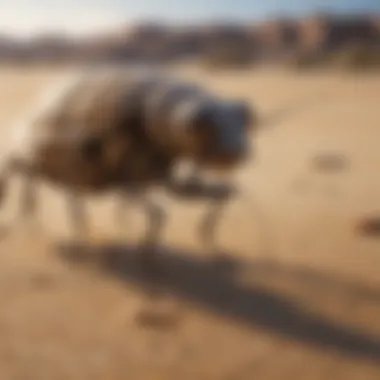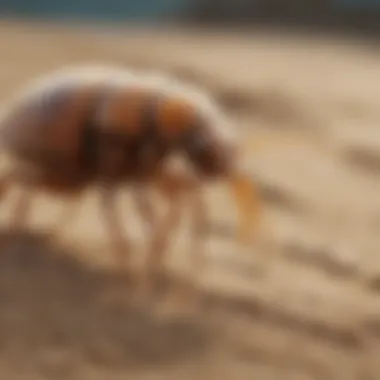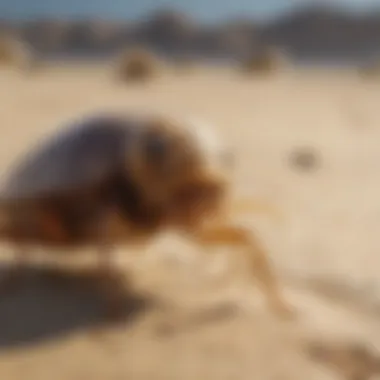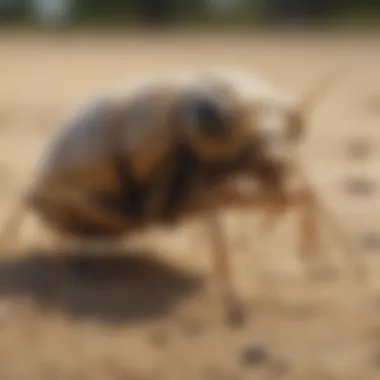Expert Tips on Eradicating Sand Fleas from Your Yard


Animal Species Profile
Sand fleas are minuscule crustaceans belonging to the Talitridae family. These small creatures have a slender body with a characteristic curved shape that helps them move effortlessly through sandy terrains. Their coloration varies from pale white to light brown, camouflaging them effectively in their natural habitat. Sand fleas are predominantly found in coastal regions worldwide, where sandy environments with a mix of moisture provide an ideal setting for their proliferation.
Their behavior is intriguing, as they are primarily nocturnal and emerge from their sandy burrows at night to feed on organic matter and detritus. Sand fleas are known for their jumping abilities, enabling them to navigate sandy surfaces with agility. Socially, these creatures tend to cluster in colonies within sand dunes or beach areas, showcasing communal tendencies in their habitats.
Understanding Sand Fleas
Sand fleas, also known as beach hoppers or sand hoppers, are small crustaceans that inhabit sandy beaches and yards. Understanding sand fleas is crucial in effectively eradicating them from your yard. By comprehending their behavior and habits, you can implement appropriate control measures. This section will delve into the lifecycle and preferred habitat of sand fleas, shedding light on key aspects that are essential for successful sand flea elimination.
Sand Fleas Behavior
Lifecycle of Sand Fleas
The lifecycle of sand fleas plays a pivotal role in their population dynamics. Understanding this aspect is vital for targeting specific life stages during control efforts. Sand fleas undergo a metamorphosis from eggs to larvae to adults. The eggs are laid in the sand, where they hatch and develop into larvae before maturing into adults. This cyclical process influences the abundance of sand fleas in your yard, making it imperative to disrupt their life cycle for effective control.
Preferred Habitat of Sand Fleas
Sand fleas prefer sandy environments near the coast or in yards with sandy soil. Their habitat choice is driven by the need for moisture and organic matter present in sand. The loose and sandy texture provides an ideal environment for sand fleas to burrow and reproduce. Understanding their preference for specific habitats enables targeted control measures, such as removing excess moisture and organic debris from your yard. While their habitat choice offers advantages for survival, it also makes them susceptible to certain control methods tailored to sandy environments.


Identifying Sand Flea Bites
Sand flea bites can be a nuisance, causing itching and discomfort. Recognizing the characteristics and symptoms of sand flea bites is crucial for prompt treatment and prevention of further infestations. By identifying these bites early, you can take steps to eliminate sand fleas from your yard and protect yourself and your loved ones from potential health risks.
Characteristics of Sand Flea Bites
Sand flea bites typically appear as small red bumps on the skin, often accompanied by itching and inflammation. The characteristic pattern of these bites, resembling clusters or lines, distinguishes them from other insect bites. Understanding these distinctive features aids in differentiating sand flea bites from mosquito or flea bites, guiding targeted control measures to address the root cause.
Symptoms of Sand Flea Bites
In addition to the visible characteristics, sand flea bites can cause various symptoms, including itching, swelling, and in some cases, allergic reactions. The intensity of symptoms may vary depending on individual sensitivity to sand flea saliva. Recognizing these symptoms is essential for determining appropriate treatment options and preventing further bites. By understanding the implications of sand flea bites, you can take proactive steps to mitigate their impact and create a safer outdoor environment.
Natural Methods for Sand Flea Control
In the pursuit of creating a sand flea-free yard, the utilization of natural methods holds significant importance. These approaches offer a safer alternative to chemical solutions, promoting environmental health and sustainability. Natural methods for sand flea control underscore the harmonious balance between pest management and ecosystem preservation. By embracing natural techniques, individuals can cultivate a healthier outdoor environment while effectively addressing sand flea infestations.
Maintaining Yard Hygiene
Regular Lawn Mowing
Regular lawn mowing stands as a fundamental practice in upholding yard hygiene and deterring sand fleas. This method involves keeping the grass trimmed to a specified height, limiting hiding spots for sand fleas and disrupting their reproductive cycle. The consistent application of regular lawn mowing serves as a proactive measure in reducing the population of sand fleas within the yard. Its simplicity and efficiency make it a popular choice for integrated pest management strategies.


Removing Standing Water Sources
The removal of standing water sources is crucial in preventing sand flea breeding grounds. Standing water provides an ideal environment for sand fleas to reproduce and thrive. By eliminating stagnant water pools, such as birdbaths or clogged gutters, individuals can significantly reduce the presence of sand fleas in their yard. This method serves as a preventive measure that disrupts the life cycle of sand fleas, curbing their population growth and mitigating infestation risks.
Repellent Plants
Incorporating repellent plants like lavender and marigold in outdoor spaces contributes to natural sand flea control. Lavender emits a fragrant scent that repels not only sand fleas but also other pests, making it a versatile choice for pest management. Marigold, known for its vibrant blooms, serves as a natural deterrent against sand fleas due to its strong aroma. These plants not only enhance the aesthetic appeal of the yard but also act as natural barriers against sand flea infestations, offering a sustainable and eco-friendly solution.
Chemical Control Methods
In the battle against sand fleas infesting your yard, chemical control methods play a crucial role. These methods offer a potent solution to eradicate these pesky pests effectively. By utilizing specific chemicals, you can target sand fleas with precision and efficiency. Considerations such as safety, environmental impact, and effectiveness are paramount when opting for chemical control.
Insecticidal Sprays
Permethrin-based Sprays
Permethrin-based sprays stand out as a formidable weapon in combating sand fleas. Their key characteristic lies in their ability to disrupt the nervous system of these insects, ultimately leading to their demise. The effectiveness of permethrin-based sprays against sand fleas makes them a popular choice for addressing infestations. While their unique feature of rapid action delivers quick results, it is essential to follow safety guidelines due to their chemical composition. Despite their advantages in swiftly eliminating sand fleas, potential drawbacks include environmental implications that require careful consideration.
Pyrethroid Sprays
Pyrethroid sprays offer another effective option for controlling sand fleas. Their key characteristic involves targeting the nervous system of pests, causing paralysis and eventual death. The popularity of pyrethroid sprays stems from their proven track record in eradicating sand flea populations. One of the unique features of pyrethroid sprays is their residual effect, providing prolonged protection against reinfestation. While advantageous for long-term control, users should be mindful of potential environmental impact. Understanding the advantages and disadvantages of pyrethroid sprays is crucial for informed decision-making in combating sand fleas.


Professional Pest Control Services
Professional pest control services, such as hiring exterminators, offer a comprehensive solution for severe sand flea infestations. The specific aspect of hiring exterminators lies in their expertise and specialized knowledge in handling pest issues. Choosing to engage exterminators is a beneficial choice when dealing with extensive sand flea problems that require professional intervention. The key characteristic of exterminators is their tailored approach to each infestation, utilizing targeted strategies for effective control. The unique feature of hiring exterminators is the convenience and assurance of thorough pest eradication. While advantageous for ensuring complete removal of sand fleas, some considerations include the cost implications and reliance on external expertise.
Preventive Measures
In our quest to rid our yards of sand fleas, preventive measures play a pivotal role. By focusing on preventive steps, we can significantly reduce the chances of these pesky creatures infesting our outdoor spaces. Regular yard inspections form the cornerstone of our preventive strategy.
Regular Yard Inspections
Regular yard inspections are a fundamental aspect of eliminating sand fleas from our environment. By diligently inspecting our yards, we can identify potential breeding sites where sand fleas thrive. This proactive approach allows us to nip infestations in the bud before they escalate. Checking for breeding sites is a crucial component of yard inspections.
Checking for Breeding Sites
During yard inspections, focusing on identifying breeding sites is paramount. By locating areas with high sand flea activity, we can target these specific zones for treatment. Checking for breeding sites involves thoroughly examining potential hiding spots such as moist soil, leaf litter, or shaded areas where sand fleas are likely to lay their eggs. This meticulous approach helps disrupt the sand flea lifecycle and prevents future generations from taking hold in our yard. The thoroughness of this process is key to its effectiveness, ensuring no stone is left unturned in our mission to eliminate sand fleas.
Applying Barrier Treatments
In addition to regular inspections, applying barrier treatments provides an added layer of defense against sand fleas. Two common barrier treatments, diatomaceous earth and boric acid, offer distinct advantages in our battle against these pests.
Diatomaceous Earth
Diatomaceous earth is a natural substance that effectively eradicates sand fleas by dehydrating their exoskeletons upon contact. This fine powder acts as a barrier, dehydrating and ultimately killing sand fleas that come into contact with it. Its non-toxic nature makes it a preferred choice for environmentally conscious individuals seeking chemical-free pest control solutions. Diatomaceous earth's abrasive properties puncture the outer shells of sand fleas, leading to their demise without posing any harm to other wildlife in the yard.
Boric Acid
Boric acid is another effective barrier treatment against sand fleas. This substance disrupts the digestive systems of sand fleas upon ingestion, leading to their incapacitation and eventual death. Boric acid's mode of action targets sand fleas specifically, making it a precise and efficient solution for combating these pests. However, caution must be exercised when using boric acid, as it can be harmful if ingested by pets or wildlife. Proper application and placement ensure that boric acid serves its purpose effectively while minimizing risks to non-target species.







